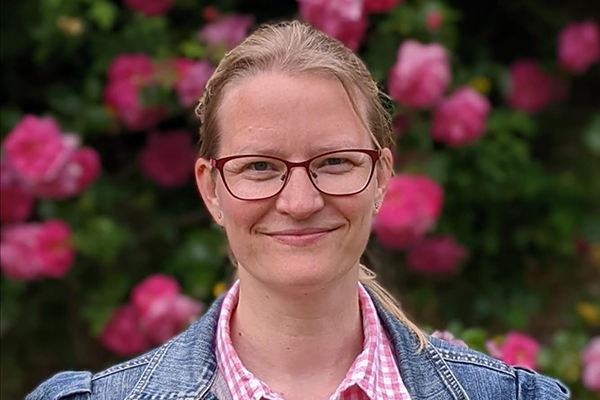Dr Karna Hansson

Agriculture, Health and Environment Department
Natural Resources Institute, Faculty of Engineering & Science
Dr K. Hansson joined the Natural Resources Institute in 2022 as a postdoctoral Research Fellow. As part of the Ecosystem Services research group at NRI, she studies the contribution of root dynamics to carbon balance of agroforestry coffee plantations in Costa Rica. Her background is in forest ecology, specialising in fine root dynamics and carbon and nutrient cycling in forest ecosystems.
Dr Hansson obtained her MSc in soil science from the Swedish University of Agricultural Sciences, Uppsala, in 2004. Her PhD in Ecology from the same university, titled ‘Impact of Tree Species on Carbon in Forest Soils’ (2011), focused mainly on differences in carbon storage in pine, spruce and birch stands in southern Sweden.
As a postdoctoral researcher at the French National Forest Institute (INRA), she studied the relationship between soil chemical properties, biogeochemical cycling and stand productivity, with the purpose to increase understanding of forest soil chemical fertility.
After a career break, she was awarded a Daphne Jackson Fellowship to join NRI in spring 2022.
- Fine root dynamics
- Carbon budgets
- Nutrient cycling
- Soil fertility
Current research project (Daphne Jackson Fellowship 2022-2024): Contribution of root dynamics to carbon balance of agroforestry coffee plantations - a case study in Costa Rica
Accurate carbon budgets are important when estimating the potential benefits of reforestation programmes for climate change mitigation. Including crop specific data makes estimates more accurate. Coffee is an important crop, often grown in agroforestry systems considered to sequester carbon. However, little is understood about contributions of plant roots to the system carbon balance.
Carbon dynamics in agroforestry coffee plantations will be studied, in a long term experiment in Costa Rica. Carbon stocks have been previously estimated at the site, but without including root biomass and turnover. Results showed that large aboveground biomass alone cannot explain increased soil carbon storage in these agroforestry systems. The aim is to i) study belowground biomass and production, and how that correlates with soil carbon stocks and aboveground biomass, and ii) make carbon budget calculations, incorporating fine root dynamics.
Previous research (postdoc): Chemical fertility of forest soils: concepts, influencing factors and the definition of reliable indicators
Dr Hansson compiled a data base with data from 49 forest sites in France, Brazil and Congo. This included nutrient pools and fluxes, as well as tree growth data. She studied the relationship between soil chemical properties, as well as biogeochemical cycling at some of the sites, and stand productivity, with the purpose to increase understanding of forest soil chemical fertility. This work resulted in two research articles, published in the Journal Forest Ecology and Management in 2020.
Previous research (PhD): Impact of Tree Species on Carbon in Forest Soils.
Karna’s PhD thesis compared soil C fluxes and the accumulation of soil organic carbon under adjacent Norway spruce, Scots pine and silver birch stands growing on similar soils and examined the different processes involved. This was achieved mainly through field measurements of carbon pools and fluxes in southern Sweden, combined with respiration and decomposition studies in the laboratory. Soil carbon fluxes and the accumulation of soil organic carbon were found to differ between the three species, with the strongest differences in humus layers between spruce and birch, with pine intermediate. Species differences can be explained by differences in tree growth rate and decomposition. This PhD resulted in 8 publications.
- Legout A., Hansson K., van der Heijden G., Laclau J-P., Mareschal L., Nys C., Nicolas M., Saint-André L., Ranger J. 2020. Chemical fertility of forest ecosystems. Part 2: Towards redefining the concept by untangling the role of the different components of biogeochemical cycling. Forest Ecology and Management, vol 461. (https://doi.org/10.1016/j.foreco.2019.117844)
- Hansson K, Laclau J-P., Saint-André L., Mareschal L., van der Heijden G., Nys C., Nicolas M., Ranger J., Legout A. 2020. Chemical fertility of forest ecosystems. Part 1: Common soil chemical analyses were poor predictors of stand productivity across a wide range of acidic forest soils. Forest Ecology and Management, vol 461. (https://doi.org/10.1016/j.foreco.2019.117843)
- Hansson K., Fröberg M., Helmisaari H-S., Kleja D.B., Olsson B.A., Olsson M., Persson T. 2013. Carbon and nitrogen pools and fluxes above and below ground in spruce, pine and birch stands in southern Sweden. Forest Ecology and Management vol 309 28-35. (https://doi.org/10.1016/j.foreco.2013.05.029)
- Hansson K., Helmisaari H-S., Sah S., Lange H. 2013. Fine root production and turnover of tree and understorey vegetation in Scots pine, silver birch and Norway spruce stands in SW Sweden. Forest Ecology and Management, vol 309 58-65. (https://doi.org/10.1016/j.foreco.2013.01.022)
- Hansson K., Olsson B.A, Olsson M., Johansson U., Kleja D.B. 2011. Differences in soil properties in adjacent stands of Scots pine, Norway spruce and silver birch in SW Sweden. Forest Ecology and Management vol 262 522-530. (https://doi.org/10.1016/j.foreco.2011.04.021)
- Daphne Jackson Fellowship, sponsored by the Natural Environment Research Council (NERC). 0.5FTE for 2 years from 1 st May 2022 to 30 th April 2024.
- Stiftelsen Konung Carl XVI Gustafs 50-årsfond för vetenskap, teknik och miljö 100 000 SEK (£8200), ”for research on forest tree turnover of fine roots and its impact on soil carbon stocks and fertility”, research award by King Carl XVI Gustaf of Sweden, 2012.

